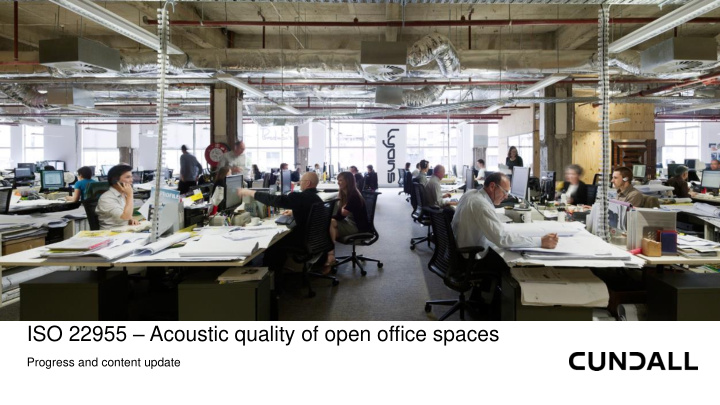



ISO 22955 – Acoustic quality of open office spaces Progress and content update
The history
The history • ISO committee convened in December 2017 • ISO TC/43 • Meetings so far in Paris, London, Birmingham, Madrid and Amsterdam • Contributors from France, Germany, UK, US, Netherlands, Sweden and Norway • Initially based on NF S31-199 • Desire to use ISO 3382: 3 parameters in international application • Low levels of input from key stakeholders such as Netherlands, Finland and Australia • Final CD draft issued to ISO for internal comment and comments received • Draft International Standard now complete • Publication 2020
Key features
Scope • Space type 1: when the activity isn’t known yet – vacant floor plate; • Space type 2: activity mainly focusing on outside of the room communication (by telephone/audio/video); • Space type 3: activity mainly based on collaboration between people at nearest workstation; • Space type 4: activity based on a small amount of collaborative work; • Space type 5: activity which may involve receiving the public; • Space type 6: combining activities within the same space.
Design for privacy
Design for collaboration
Design for general use – some collaboration
Design for public offices (e.g. ticket offices)
D A,S
Cat A design
Key issues
Bones of contention • Long discussions about STI • Inaccurate to use in design and measure? • Surely everything comes down to STI? • Long discussions about background noise • Occupancy density • In Europe 1:10 or 1:12 m 2 • In co-working can be 1:4 m 2 • Cultural differences and expectations • National guidance and rating systems in Scandinavia • Different concepts of Shell & Core, Cat A and Cat B • Conflicts with national and local guidance • Legislation takes precedence
Key issues • Many of the target criteria unproven, based on theory • Strict labour laws in France and Germany • Different working styles • UK, US and Netherlands more collaborative working • Central Europe more autonomous working • Scandinavia silent at desks • Co-working! • Speech masking highly contentious • Each member country does things differently! • End product will be majority, not consensus, view • Consultation responses welcome
www.linkedin.com/company/cundall www.cundallconversations.com www.cundall.com @Cundall_Global
Recommend
More recommend